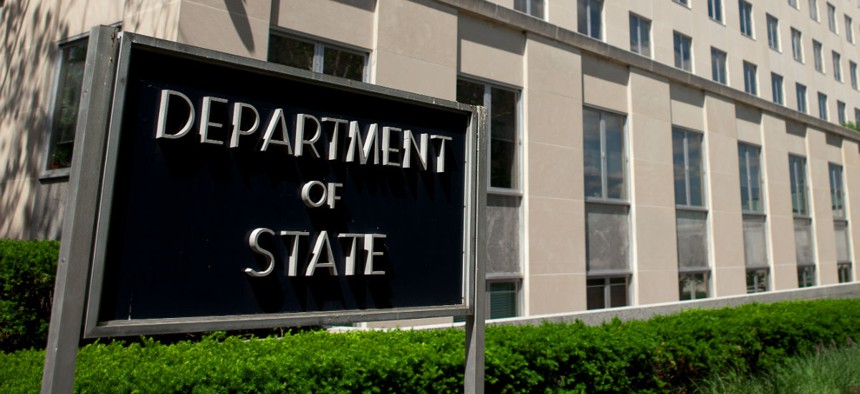Foreign Service Is Being Depleted at a 'Dizzying Speed,' Union Says
Cuts "are hard to square with the stated agenda of making State and the Foreign Service stronger," says leader of current and retired diplomats.
The habitually cautious American Foreign Service Association is becoming more aggressive in protesting the departures and budget cuts unfolding at the State Department.
In a just-released preview of a letter planned for the December issue of the Foreign Service Journal, AFSA president Barbara Stephenson wrote of a “new urgency,” saying “there is simply no denying the warning signs that point to mounting threats to our institution—and to the global leadership that depends on us.”
Invoking a recent Time magazine cover portraying President Trump as a wrecking ball “dismantling government as we know it,” Stephenson condemned Secretary of State Rex Tillerson’s decision to “slash promotion numbers by more than half. The Foreign Service officer corps at State has lost 60 percent of its career ambassadors since January,” she said. “Ranks of career ministers, our three-star equivalents, are down from 33 to 19. The ranks of our two-star minister counselors have fallen from 431 right after Labor Day to 369 today—and are still falling.”
The former ambassador said the numbers “are hard to square with the stated agenda of making State and the Foreign Service stronger. Were the U.S. military to face such a decapitation of its leadership ranks, I would expect a public outcry. Like the military, the Foreign Service recruits officers at entry level and grows them into seasoned leaders over decades. The talent being shown the door now is not only our top talent, but also talent that cannot be replicated overnight. The rapid loss of so many senior officers has a serious, immediate and tangible effect on the capacity of the United States to shape world events.”
The hiring freeze, Stephenson added, is causing entry-level intake of new Foreign Service officers to drop from 366 in 2016 to about 100 new officers joining in 2018. And fewer than half as many people as usual have signed up to take the Foreign Service officer test this year.
“Congress rejected drastic cuts to State and USAID funding,” Stephenson noted. “The Senate labeled the proposed cuts a ‘doctrine of retreat.’ Given this clear congressional intent, we have to ask: Why such a focus on slashing staffing at State? Why such a focus on decapitating leadership? How do these actions serve the stated agenda of making the State Department stronger?...Where is the mandate to pull the Foreign Service team from the field and forfeit the game to our adversaries?”
Asked for comment, a State Department spokesman challenged the accuracy of the assertion that the Foreign Service is undergoing drastic cuts, citing Tillerson’s ongoing redesign of the department. “The State Department has never had a comprehensive, employee-led review of its functions, and there’s no better time than now to see how we can improve them,” it said. “The goal of the redesign has always been to find new ways to best leverage our team’s brains, ingenuity, and commitment to serving our nation’s interests. AFSA and other employee groups are important partners in the redesign effort. As has been said many times before, the freezes on hiring and promotions are only temporary while we study how to refine our organization.”
The department also supplied numbers that differ from AFSA’s:
- As of October 31, 2017, the Senior Foreign Service is comprised of 976 diplomats, with 63 waiting for Congress to attest their promotion into the senior ranks. Once these promotions are attested, there will be 1039 Senior Foreign Service Officers, a number nearly identical to the 1058 Senior Foreign Service Officers at the same point in 2016.
- From February 1 to September 30, fewer Foreign Service Officers and Foreign Service Specialists combined retired in 2017 (244) than they did in 2016 (249).
- A 60 percent reduction in career ambassadors is a “misleading description,” it said. “In January 2017 there were five career ambassadors serving. Three retired this year. Today, two serve with this rank, which is within the historical norms of 1 to 7 at any one time since 1980. …The secretary plans to nominate individuals for this role in the near future."
- In 2015, 14,480 individuals took the Foreign Service Officer test. In 2016, 11,886 took it. This year 9,519 took the test, the department said. “This trend corresponds with an improving economy and similar trends have been observed in the past.”
An AFSA spokesman said releasing the column early has become common this year as a way to weigh in on issues “of the moment.”
Since the start of the Trump administration, AFSA has been posting quotes from lawmakers and current and former officials who share its concerns under the heading “Defending the Foreign Service.”
Some critics have faulted AFSA for not speaking out more strongly on specific issues the way other retired diplomats might. In an August blogpost, the commentator known as Diplopundit used a headline reading, “What’s That Sound? That’s AFSA Drilling a Hole In Search of Its Missing Backbone.”




